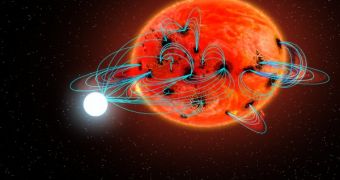Dwarf stars are known to astronomers for some time now, but never has an association of two dwarfs been of such great interest for the scientific community.
A white dwarf is an astronomical object which is produced when a star of low or medium mass dies. These stars are not massive enough to generate the core temperatures required to continue nuclear fusion reactions in the cold space.
Ultra-cool dwarfs , or brown dwarfs are sub-stellar objects with a mass below that necessary to maintain hydrogen-burning nuclear fusion reactions in their cores, as do stars on the main sequence, but which have fully convective surfaces and interiors, with no chemical differentiation by depth. Brown dwarfs occupy the mass range between that of large gas giant planets and the lowest mass stars (anywhere between 75 and 80 Jupiter masses).
British scientists from the University of Hertfordshire have discovered a rare co-orbiting pair of stars, made up of a white dwarf, and an ultra-cool dwarf, that has the widest separation ever detected in this type of binary system.
Avril Day-Jones, who presented the discovery at the RAS National Astronomy Meeting in Preston, said: "This is a record breaking discovery for a system of this kind."
"In the other few binary cases that are known, the objects are relatively close together. In this new system, the objects are 600 billion kilometers apart which is hundreds of times wider."
The team believes that the two objects formed at roughly the same time and were originally much closer together.
Elusive ultra-cool dwarfs during the death-throes of the white dwarf's progenitor star, forces induced when gas and dust from the star were thrown off into space caused the ultra-cool dwarf spiral out to its remote position. Miss Day-Jones added: "Ultra-cool dwarfs are elusive objects and we don't know that much about them.
"This type of binary allows us to use our knowledge of white dwarfs, which we understand quite well, to infer properties of the ultra-cool dwarf, such as the temperature, surface gravity, mass and age. We need to discover more of this type of binary system if we want to improve our understanding of ultra-cool dwarfs."

 14 DAY TRIAL //
14 DAY TRIAL //